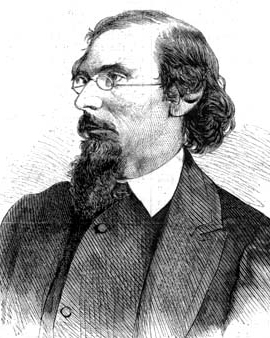George Inness was born in Orange County in 1825, and became one of the most famous American painters of the 19th century. He grew up in an extended family of twelve siblings, which was not uncommon at that time. His father worked as a grocer and provided the family with financial security. Already as a teenager, little George was engaged in art and painting. He also worked as an engraver of maps. During this activity he transferred scenes from nature to small wheels and rollers. At work he met Regis Gignoux, a French painter from Lyon. They became friends and moved to New York City together to study art. Also during his studies, happy coincidences in his life happen. Ogden Haggerty Hammond becomes aware of George and finances a trip to Europe for him. Hammond was a well-known local politician from the state of New Jersey, who worked as a bank director and later as ambassador for the United States of America.
George Inness takes the chance he gets from Ogden Hammond and moves to Italy. He then spends another year in France. Here he develops his art style strongly. Early on his paintings were influenced by the American Hudson River School, but in France he was fascinated by artists from the Barbizon School, who became famous for their landscape paintings. The Barbizon landscape painting was characterized by the strong emphasis of moods through dark colors and a loose brushwork. Inness returned to America and introduced the Barbizon style. He further developed the style, giving it a very individual touch, which was praised by American landscape painters. His work became increasingly popular and he received commissions from private individuals and companies. In 1850 Inness was commissioned by the Delaware, Lackawanna and Western Railroad Company to produce paintings that pictorially documented the development of the railway company.
Later, he was inspired by the work of William James, who went down in American art history with the "stream of thoughts". He tried to capture the mystical in his pictures and to make the viewer understand the emotional worlds that are difficult to describe. He was also interested in the theology of Emanuel Swedenborgs, who founded the "Swedish idea" in 1860. He drew inspiration from the story of creation and wanted to depict spiritual connections between people on earth and God in heaven in his paintings. He became a member of several art institutions, including the National Academy of Design in New York. George Inness dies at the age of 69 during a trip to England in the small town of Bridge of Allan. Some of his paintings are now in the possession of museums where they are presented to the public. This is also the case at the National Gallery in Washington or the Art Institute in Chicago. In Europe, some of his works can be found in the Musée d'Orsay in Paris.
×





.jpg)
.jpg)
.jpg)
.jpg)
.jpg)
.jpg)
.jpg)
.jpg)
.jpg)
.jpg)
.jpg)
.jpg)
.jpg)
.jpg)
.jpg)
.jpg)
.jpg)
.jpg)
.jpg)
.jpg)
.jpg)
.jpg)
.jpg)
.jpg)
.jpg)
.jpg)
.jpg)
.jpg)
.jpg)
.jpg)
.jpg)
.jpg)
.jpg)
.jpg)
.jpg)
.jpg)
.jpg)
.jpg)
.jpg)
.jpg)
.jpg)
.jpg)
.jpg)
.jpg)
.jpg)
.jpg)
.jpg)
.jpg)
.jpg)
.jpg)
.jpg)
.jpg)
.jpg)
.jpg)
 - (MeisterDrucke-11120).jpg)
 - (MeisterDrucke-11120).jpg)
.jpg)
.jpg)
.jpg)
.jpg)
.jpg)
.jpg)
.jpg)
.jpg)
.jpg)
.jpg)
.jpg)
.jpg)
.jpg)
.jpg)
.jpg)
.jpg)
.jpg)
.jpg)
.jpg)
.jpg)
.jpg)
.jpg)
.jpg)
.jpg)
.jpg)
.jpg)
.jpg)
.jpg)
.jpg)
.jpg)
.jpg)
.jpg)
.jpg)
.jpg)
.jpg)
.jpg)
.jpg)
.jpg)
.jpg)
.jpg)
.jpg)
.jpg)
.jpg)
.jpg)
.jpg)
.jpg)
.jpg)
.jpg)
.jpg)
.jpg)
.jpg)
.jpg)
.jpg)
.jpg)
.jpg)
.jpg)
.jpg)
.jpg)
.jpg)
.jpg)
.jpg)
.jpg)
.jpg)
.jpg)
.jpg)
.jpg)
.jpg)
.jpg)
.jpg)
.jpg)
.jpg)
.jpg)
.jpg)
.jpg)
.jpg)
.jpg)
.jpg)
.jpg)
.jpg)
.jpg)
.jpg)
.jpg)
.jpg)
.jpg)
.jpg)
.jpg)
.jpg)
.jpg)
.jpg)
.jpg)
.jpg)
.jpg)
.jpg)
.jpg)
.jpg)
.jpg)
.jpg)
.jpg)
.jpg)
.jpg)
.jpg)
.jpg)
.jpg)
.jpg)
.jpg)
.jpg)
.jpg)
.jpg)
.jpg)
.jpg)
.jpg)
.jpg)
.jpg)
.jpg)
.jpg)
.jpg)
.jpg)
.jpg)
.jpg)
.jpg)
.jpg)
.jpg)
.jpg)
.jpg)
.jpg)
.jpg)
.jpg)
.jpg)
.jpg)
.jpg)
.jpg)
.jpg)
.jpg)
.jpg)
.jpg)
.jpg)
.jpg)
.jpg)
.jpg)
.jpg)
.jpg)
.jpg)
.jpg)
.jpg)






